
Héctor Ruiz Martín and Rodger W. Bybee.
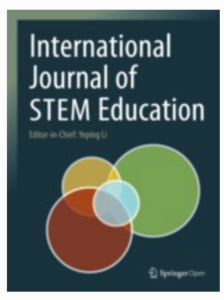
The International Journal of STEM Education includes in its March issue The cognitive principles of learning underlying the 5E Model of Instruction, an article that outlines the principles from cognitive sciences on how people learn that underlie the 5E Model and that could theoretically explain the effectiveness of the model as a learning sequence. The article is written by Héctor Ruiz Martín, director of the International Science Teaching Foundation, and Rodger W. Bybee, director of the team that developed the 5E Model itself.
THE 5E MODEL
The 5E Model is a proposal to structure the didactic units in sciences and technology subjects. Developed by the Biological Sciences Curriculum Study (BSCS) in 1987, the proposal drew on other teaching models such as the Atkin-Karplus Learning Cycle, or the Science Curriculum Improvement Study (SCIS) learning cycle. In the last few decades, and following on from the introduction of this proposal in classroom environments, multiple studies have provided evidence of significant improvements in conceptual learning, development of scientific skills, and interest in science by students.
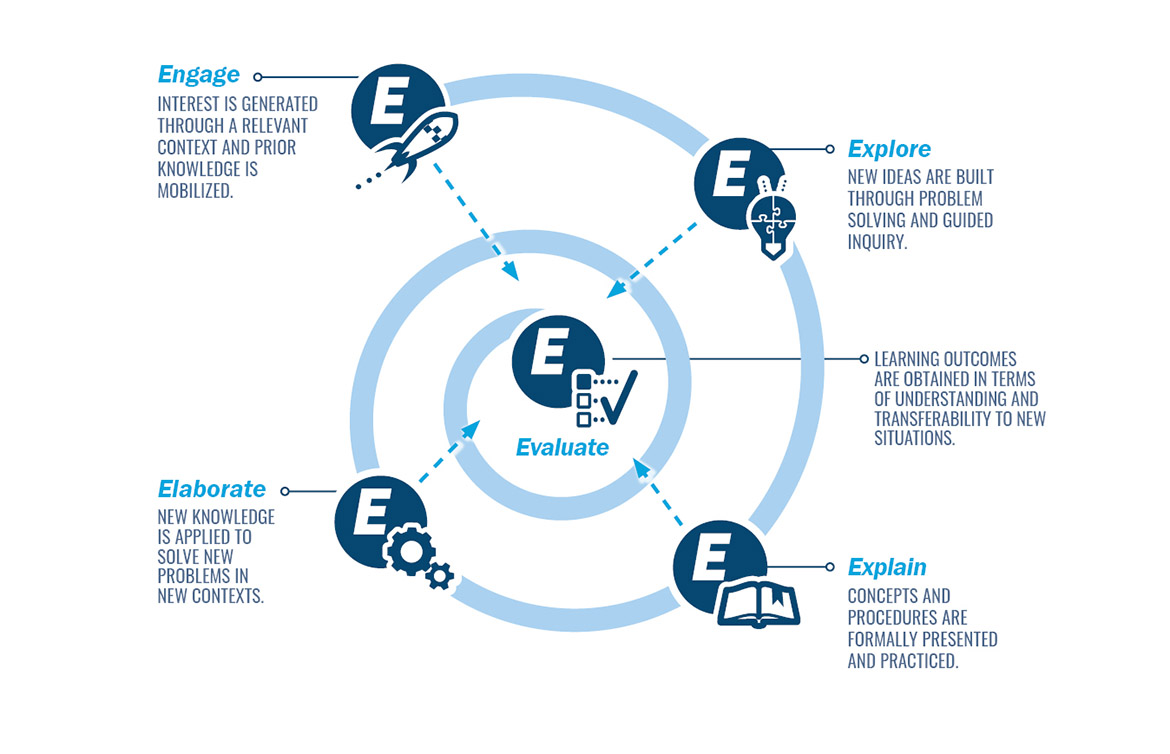
THE STAGES
The 5E Model consists of five stages: engage, explore, explain, elaborate, and evaluate. Ruiz Martín and Bybee’s dissertation establishes links between each of these stages and the scientific literature in the field of how people learn (mainly in cognitive psychology, developmental psychology, and neuroscience):
Engage
In this stage, the teacher introduces a problem or an event in a familiar context that the students are not able to explain because it does not fit with their previous knowledge. This situation promotes two types of engagement: contextual (extrinsic) and cognitive (intrinsic). The first type is based on the fact that students become aware of the implications of the situation in real life, that is, they recognize its instrumental value. The second type is based on the curiosity that arises when people realize that their knowledge cannot satisfactorily explain an observation that puzzles them. This cognitive conflict plays a key motivating role because, as pointed out in the classic model of conceptual change, it creates a need in the students to acquire a more adequate explanatory model.
This stage provides an opportunity to activate the students’ prior knowledge. The scientific literature shows that mobilizing the ideas that students already have of the topic they are learning about facilitates the integration of new knowledge, since learning consists precisely in making connections between what is known and the information coming from new experiences. This is because human memory does not store redundant information, but rather uses the already consolidated information to build new memories that share those characteristics.
But learning is not only a process of assimilation, in which new information is incorporated into existing knowledge structures, but also often requires a process of accommodation. In this process, the learner’s prior conceptual structures must be restructured to allow the new knowledge to fit with their understanding.
In this stage, the role of teachers is to guide students’ thinking towards those aspects relevant to the learning task. While some students may spontaneously activate their prior knowledge as they are engaged in learning, some others need support and guidance, and the teacher can help by providing explicit opportunities to do so. In this respect, the classroom dynamics during this stage provide interesting opportunities for group discussions and cooperative learning, two socio-cognitive strategies that can lead to richer teaching and learning environments.
Explore
The explore stage consists of a teacher-guided inquiry activity that provides students opportunities to solve the cognitive conflict presented to them in the first stage, and to build new explanations that make sense to them.
Therefore, this stage seeks to promote the connections between the students’ prior knowledge and the new ideas to be learned. To do this, the activities of this stage follow a guided inquiry-based approach that encourages reasoning and the construction of meaning by students. This approach is supported by one of the most basic findings of cognitive psychology: people learn and remember better when they process what they are learning in terms of meaning, that is, when they try to understand it. In this respect, the way the learning activities are organized in this stage prompts students to think about what they are learning in order to make progress.
The role of the teacher is key in providing a cognitive scaffolding that allows students to make progress in their reasoning and conclusions, and encouraging students to help each other solve problems based on the knowledge of the class group. The teacher poses problems, asks questions to clarify explanations, and suggests ways in which the group can move towards its goal, leaving it up to the student themselves to reformulate their explanations by inferring them from new observations. Research shows that both cooperation in problem-solving activities and argumentation enhance students’ cognitive development.
Explain
In the explain stage, teachers directly and formally introduce the concepts developed in the explore stage, and help students organize their new knowledge in such a way as to facilitate acquisition and the ability to later apply what they know.
Research has shown that when students are given an organizational structure into which to fit new knowledge, they learn more effectively than when they are left to infer this conceptual structure by themselves.
Of course, as in the previous phases, the formal definitions and explanations of the models and concepts can also be built cooperatively by the students with close guidance by the teacher.
Elaborate
The elaborate stage challenges students to apply what they have learned in solving problems in new contexts. At this stage, the knowledge acquired is shown to be “productive,” that is, useful for understanding and addressing situations other than those used to build the concepts and procedures.
Research suggests that exposing students to multiple contexts fosters deeper understanding. Decontextualization is likely to push the student to abstract the relevant features of the worked concepts and thus develop a flexible representation of knowledge. This is the property that allows the new knowledge to be transferred to new situations.
Evaluate
Finally, in the evaluate stage, the knowledge and skills acquired by each student are assessed through an activity that challenges their understanding. Although the traditional model places evaluation at the end of the learning sequence, the designers of Model 5E recommend integrating the evaluation stage throughout the entire sequence.
From a cognitive perspective, evaluation is not only useful for assessing learning and providing feedback on the student’s acquisition of knowledge. Cognitive psychologists have shown that retrieving information from long-term memory is one of the most effective ways to reinforce learning, even more so than restudy.
Therefore, the evaluation stage of the 5Es is also a learning stage, especially if it is used throughout the entire learning sequence and not only at the end.
CONCLUSIONS
The 5E Instructional Model was designed in the late 1980s with the idea of translating decades of research in the field of science education into a learning cycle that teachers could use effectively in their classrooms. Meanwhile, cognitive science research can substantiate the benefits of learning this model, whose stages fit with what we know about how people learn.
In fact, it could be argued that the 5E Model is effective because students are allowed time, guidance, and several opportunities to cognitively engage with the learning object in a way that leads them to make connections between what they know and what they are proposed to learn.

Link to the original article: https://stemeducationjournal.springeropen.com/articles/10.1186/s40594-022-00337-z
ABOUT THE AUTHORS

Héctor Ruiz Martín is an independent researcher affiliated with the International Science Teaching Foundation (Brighton, UK), a nonprofit organization that develops research‑informed resources for science teaching and learning. Some of these resources are based on the 5E Model of Instruction.

Rodger W. Bybee led the team at the Biological Science Curriculum Study (BSCS) that designed and created the 5E Model of Instruction in 1987. The BSCS (Boulder, CO, USA) is an independent nonprofit organization offering science education research and leadership programs, and curriculum across the US.
RELATED ARTICLES


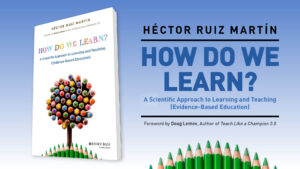
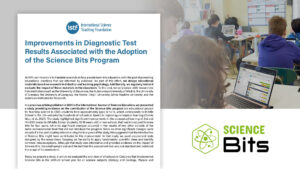
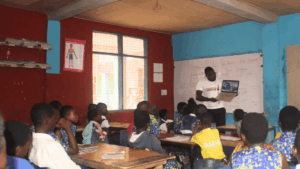






Leave a Reply